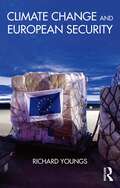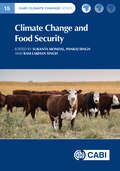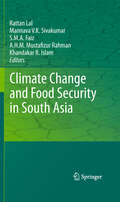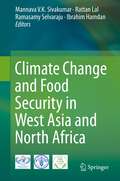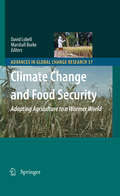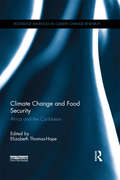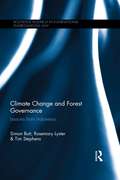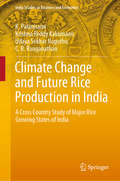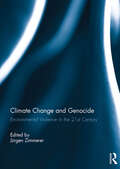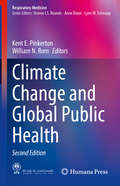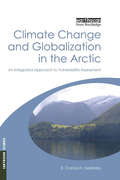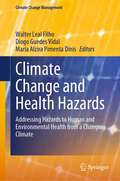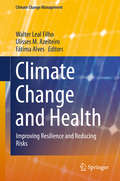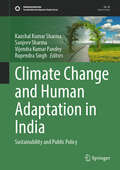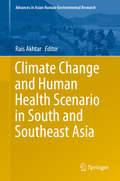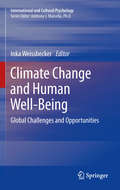- Table View
- List View
Climate Change and European Security (Routledge Advances in European Politics)
by Richard YoungsIt is now commonly asserted that climate change will fundamentally change international relations. It has been predicted that global warming will increase conflict within and between states, intensify food insecurity, menace the global trading system and unleash waves of migration. As a result governments are beginning to incorporate these warnings into their foreign policy initiatives. The appropriateness of their incipient responses needs to be examined in finer detail. This book looks at the impact of climate change on European Union (EU) security policy. It explores how governments are reconfiguring their geo-strategy and broader international relations in the wake of climate change warnings. The book demonstrates that although many aspects of EU foreign policies have begun to change, ‘climate security’ is not yet accorded unequivocal or sufficient priority. In doing so, Youngs argues that if climate change policies are to have significant effect they can no longer be treated as a separate area of policy but must be incorporated into the more mainstream debates pertinent to EU common foreign and security policy (CFSP). This book will be of key interest to students, scholars and practitioners of climate change and policy, energy and environmental policy, EU governance and foreign policy, European studies, international relations, geography, security studies/policy and environmental economics.
Climate Change and Eye Disease: Eye Health and Blindness in a Hostile Environment (Routledge Studies in Environment and Health)
by Scott FraserThis book examines the impact of climate change on eye disease and eye health.Filling a lacuna in the existing literature, Scott Fraser takes a deep dive into the eye diseases that are most affected by the climate crisis and explores the subsequent burden on organisations, charities and healthcare systems. Fraser begins by including short primer chapters on the basics of climate science and climate change, highlighting which environmental mechanisms directly and indirectly affect our health and why. He then looks in detail at the direct and indirect threats to eye health from climate change and examines factors including changing insect vectors, trauma from extreme weather events such as wildfires, floods and droughts, as well as the impact of crop failure, malnutrition, animal and plant migration. Highlighting the Global North vs South divide, the book goes on to consider issues around eye care, exploring the increased burden that climate-induced chronic eye diseases including cataracts, macular degeneration and nutritional eye diseases are placing on health care systems. These chapters also reflect on the ways in which eye care, ophthalmology, optometry, pharmaceutical and medical device companies all contribute to the climate footprint themselves.Unique and timely, this book will be a great resource for students and clinicians of ophthalmology, optometry and allied eye care professions, as well as climate scientists, researchers, policy makers, charities, NGOs working in related fields of environment and health.
Climate Change and Food Security (CABI Climate Change Series)
by Edited by Sukanta Mondal, Pankaj Singh and Ram Lakhan SinghThe effects of climate change on food production and security are many and varied and represent one of the biggest challenges facing humanity today. As the human population increases there is increasing pressure on land availability and water resources. In many staple crops, warming temperatures have caused decreases in overall yields but at the same time the demand for cheaper and more sustainable food has increased. This edited volume examines the effects of climate change on all aspects of food production and how this is affecting food security in many parts of the world. The book presents a series of chapters which describe new technologies aimed at mitigating these effects via, for example, genetic modification, microbial science, and the introduction of new crops. · Information is presented in a very accessible and logical format. · The book focuses on sustainable food security and safety, illustrated with case studies. · The chapters cover the latest thinking on food security via sustainable livestock and agricultural production. · The book describes the social issues related to food safety, regulatory frameworks, and policies in the light of climate change.
Climate Change and Food Security in South Asia
by Rattan Lal A.H.M. Mustafizur Rahman Khandakar R. Islam Mannava Vk Sivakumar S.M.A. FaizThis book addresses an important topic of food security in South Asia with specific reference to climate change. Of the 1 billion food insecure people in the world, more than 30% are in South Asia. The problem of food insecurity may be exacerbated by the projected climate change especially because of the water scarcity caused by rapid melting of the glaciers in the Himalayas and increase in variability in monsoonal rains and frequency of extreme events. Furthermore, large populations of Bangladesh and other coastal regions may be displaced by sea level rise. Thus, this volume addresses recommended land use and soil/water/crop/vegetation management practices which would enable land managers to adapt to climate disruption by enhancing soil/ecosystem/social resilience. In addition to biophysical factors, this book also addresses the issues related to human dimensions including social, ethnical and political considerations.
Climate Change and Food Security in West Asia and North Africa
by Rattan Lal Mannava Sivakumar Ibrahim Hamdan Ramasamy SelvarajuThe countries of West Asia and North Africa (WANA) have long had the challenge of providing sustainable livelihoods for their populations in the fragile ecosystems of semi-arid and arid areas. Climate change is already a reality in WANA and it places additional constraints on the already fragile ecosystems of dry areas and limited natural resources in WANA. A comprehensive and integrated approach to planning and implementing the climate change adaptation strategies across the wide range of agro-ecosystems in different countries in WANA could help both the planners and the local communities to deal effectively with the projected impacts and also contribute to overall sustainability of agricultural production systems. This book addresses the important issue of climate change and food security in West Asia and North Africa and presents the appropriate strategies which could help in the development of new policies to better adapt agriculture production systems and enhance food security in WANA.
Climate Change and Food Security: Adapting Agriculture to a Warmer World (Advances in Global Change Research #37)
by David B. Lobell Marshall BurkeRoughly a billion people around the world continue to live in state of chronic hunger and food insecurity. Unfortunately, efforts to improve their livelihoods must now unfold in the context of a rapidly changing climate, in which warming temperatures and changing rainfall regimes could threaten the basic productivity of the agricultural systems on which most of the world's poor directly depend. But whether climate change represents a minor impediment or an existential threat to development is an area of substantial controversy, with different conclusions wrought from different methodologies and based on different data. This book aims to resolve some of the controversy by exploring and comparing the different methodologies and data that scientists use to understand climate's effects on food security. In explains the nature of the climate threat, the ways in which crops and farmers might respond, and the potential role for public and private investment to help agriculture adapt to a warmer world. This broader understanding should prove useful to both scientists charged with quantifying climate threats, and policy-makers responsible for crucial decisions about how to respond. The book is especially suitable as a companion to an interdisciplinary undergraduate or graduate level class.
Climate Change and Food Security: Africa and the Caribbean (Routledge Advances in Climate Change Research)
by Elizabeth Thomas HopeGlobal climatic change has resulted in new and unpredictable patterns of precipitation and temperature, the increased frequency of extreme weather events and rising sea levels. These changes impact all four aspects of food security – availability, accessibility, stability of supply and appropriate nourishment – as well as the entire food system – food production, marketing, processing, distribution and prices. Climate Change and Food Security focuses on the challenge to food security posed by a changing climate. The book brings together many of the critical global concerns of climate change and food security through local cases based on empirical studies undertaken in Sub-Saharan Africa and the Caribbean. Focusing on risk reduction and the complex nature of vulnerability to climate change, the book includes chapters on the responsiveness of farmers based on traditional knowledge, as well as the critical phenomenon of food insecurity in the urban setting. Other chapters are devoted to efforts made to strengthen resilience through long-term development, with interventions at the regional and national levels of scale. It also examines cross-cutting themes that underlie the strategies employed to achieve food security, including equity, gender, livelihoods and governance. This edited volume will be of great interest to students and scholars of climate change, food security, environmental management and sustainable development.
Climate Change and Forest Governance: Lessons from Indonesia (Routledge Research in International Environmental Law)
by Rosemary Lyster Simon Butt Tim StephensDeforestation in tropical rainforest countries is one of the largest contributors to human-induced climate change. Deforestation, especially in the tropics, contributes around 20 per cent of annual global greenhouse gas emissions, and, in the case of Indonesia, amounts to 85 per cent of its annual emissions from human activities. This book provides a comprehensive assessment of the emerging legal and policy frameworks for managing forests as a key means to address climate change. The authors uniquely combine an assessment of the international rules for forestry governance with a detailed assessment of the legal and institutional context of Indonesia; one of the most globally important test case jurisdictions for the effective roll-out of ‘Reduced Emissions from Deforestation and Degradation’ (REDD). Using Indonesia as a key case study, the book explores challenges that heavily forested States face in resource management to address climate mitigation imperatives, such as providing safeguards for local communities and indigenous peoples. This book will be of great relevance to students, scholars and policymakers with an interest in international environmental law, climate change and environment and sustainability studies in general.
Climate Change and Future Rice Production in India: A Cross Country Study of Major Rice Growing States of India (India Studies in Business and Economics)
by Udaya Sekhar Nagothu K. Palanisami Krishna Reddy Kakumanu C. R. RanganathanThis book explains in depth the issues and challenges faced by rice farmers in India in relation to production and productivity, and the possible adaptation strategies to climate change. Based on five years of groundbreaking research on emerging trends in cultivation in major rice growing regions in India, it begins by describing production and yield trends across different rice growing regions. It then offers a comprehensive review of relevant literature and the quantification methodologies and approaches used to analyze the impact of climate change. The book also analyzes climate change impacts on rice productivity and production, applying field-tested quantification methods, such as the Just-Pope production function where time series and cross-section data are simultaneously used for all regions. The results are presented for five geographical regions of India – northern, eastern, western, central and southern – for better comparison and readability. The analyses cover scenarios for both mid-century (2021–2050) and end-century (2071–2100), and in the context of climate change, they also incorporate both medium and high carbon emission scenarios. Thus the future rice production and productivity trends are clearly projected for making necessary interventions. Lastly, the book outlines the essentials of an enabling environment policy and discusses the institutional and policy options necessary to ensure sustainable rice production in India. It also makes the case for introducing appropriate and affordable adaptation strategies to support farmers in different rice-growing regions. The cost–benefit analysis of strategies presented in this book provides an invaluable tool for officials at agriculture departments planning up-scaling of agricultural productivity. The projections are also useful for policy makers and planners developing future investment plans to support rice production in their country. Overall, this book is of interest to a wide audience, including professionals and business enterprises dealing with rice, as well as to academic researchers and students.
Climate Change and Gender in Rich Countries: Work, public policy and action
by Marjorie Griffin CohenClimate change is at the forefront of ideas about public policy, the economy and labour issues. However, the gendered dimensions of climate change and the public policy issues associated with it in wealthy nations are much less understood. Climate Change and Gender in Rich Countries covers a wide range of issues dealing with work and working life. The book demonstrates the gendered distinctions in both experiences of climate change and the ways that public policy deals with it. The book draws on case studies from the UK, Sweden, Australia, Canada, Spain and the US to address key issues such as: how gendered distinctions affect the most vulnerable; paid and unpaid work; and activism on climate change. It is argued that including gender as part of the analysis will lead to more equitable and stronger societies as solutions to climate change advance. This volume will be of great relevance to students, scholars, trade unionists and international organisations with an interest in climate change, gender, public policy and environmental studies.
Climate Change and Genocide: Environmental Violence in the 21st Century
by Jürgen ZimmererClimate change caused by human activity is the most fundamental challenge facing mankind in the 21st century, since it will drastically alter the living conditions of millions of people, mainly in the Global South. Environmental violence, including resource crises such as peak fossil fuel, will lie at the heart of future conflicts. However, Genocide Studies have so far neglected this subject, due to the emphasis that traditional genocide scholarship places on ideology and legal prosecution, leading to a narrow understanding of the driving forces of genocide. This books aims at changing this, initiating a dialogue between scholars working in the areas of climate change and genocide. Research into genocide as well as climate change is a highly interdisciplinary endeavour, transcending the boundaries of established disciplines. Contributions to this book address this by approaching the subject from a wide array of methodological, theoretical, disciplinary and regional perspectives. As all the contributions show, climate change is a major threat multiplier for violence or non-violent destruction and any understanding of prevention needs to take this into account. They offer a basis for much needed Critical Prevention Studies, which aims at sustainable prevention.This book was originally published as a special issue of the International Journal of Human Rights.
Climate Change and Geodynamics in Polar Regions (Maritime Climate Change Ser.)
by Neloy KhareClimate Change and Geodynamics in Polar Regions covers most of the scientific aspects of geoscientific investigation undertaken by Indian researchers in the polar regions: the Antarctic, Arctic, and Himalayan regions. A firm understanding of the cryosphere region's geological perspectives helps students and geoscientists evaluate important scientific queries in the field. This book will help readers understand how the cryosphere’s geoscientific evolution took place in the geological past, climate change throughout history, and how polar regions were affected by global warming. It also discusses how we might expect polar climate to change in the future. A firm understanding of the cryosphere region's geological perspectives helps students and geoscientists answer some of the most puzzling scientific queries and generate new ideas for future research in this field.
Climate Change and Global Development: Market, Global Players and Empirical Evidence (Contributions to Economics)
by Tiago Sequeira Liliana ReisThis book presents new research related to climate change policies and effects. It discusses the implications of climate change on issues pertaining to international relations and economic development, and the question of how climate change could jeopardize the international system as we have known it until today. It aims to provide an empirical basis and epistemological framework to discuss the effects of climate change on economic growth, social development and welfare as a global phenomenon influenced by policies carried out transnationally and by national governments. Case studies from around the globe are presented.
Climate Change and Global Food Security
by Rattan Lal David O. Hansen B. A. StewartIn order to feed their burgeoning populations, developing nations will need to double cereal production by the year 2050. This increase will have to come from existing land, as little potential exists for bringing new land under cultivation -- a daunting prospect when one realizes that increased use and significantly higher concentrations of carbon
Climate Change and Global Health
by Professor Colin D. ButlerThere is increasing understanding, globally, that climate change will have profound and mostly harmful effects on human health. This authoritative book brings together international experts to describe both direct (such as heat waves) and indirect (such as vector-borne disease incidence) impacts of climate change, set in a broad, international, economic, political and environmental context. This unique book also expands on these issues to address a third category of potential longer-term impacts on global health: famine, population dislocation, and conflict. This lively yet scholarly resource explores these issues fully, linking them to health in urban and rural settings in developed and developing countries. The book finishes with a practical discussion of action that health professionals can yet take. Now with added chapter updating key changes affecting climate change and health through 2015, culminating with UN secretary general Ban Ki Moon's hopeful comment "What was once unthinkable is now unstoppable". Climate change, now clearly worsening, is triggering a powerful social and technological response. Will this response be sufficient to avert its potentially catastrophic "tertiary" health effects? Read a chapter for free.
Climate Change and Global Public Health: Air Pollution, Global Climate Change, And Wilderness (Respiratory Medicine #7)
by William N. Rom Kent E. PinkertonThis book is a guide to the research, findings, and discussions of US and international experts on climate change and respiratory health. Since the publication of the first edition, climate change has been increasingly acknowledged as being directly related to the prevalence and incidence of respiratory morbidity. Evidence is increasing that climate change does drive respiratory disease onset and exacerbation as a result of increased ambient and indoor air pollution, desertification, heat stress, wildfires, and the geographic and temporal spread of pollens, molds and infectious agents. This second edition is fully updated to include the latest research by international experts on topics such as heat waves causing critical care-related diseases, climate-driven air pollution increases, and high-level ozone and ozone exposure linked to idiopathic pulmonary fibrosis, lung cancer, and acute lower respiratory infection. Seven new chapters have also been added on extreme weather and agricultural safety in California; desert dust effects on lung health; climate policy and the EPA; California's integrated approach to air quality and climate change; integrating climate change, the environment, and sustainability themes into professional health science courses; and the role of the physician as climate advocate. This is an ideal guide for all pulmonologists and health professionals treating patients with pulmonary disease.
Climate Change and Globalization in the Arctic: An Integrated Approach to Vulnerability Assessment (Earthscan Climate)
by E. Carina KeskitaloClimate change vulnerability assessment is a rapidly developing field. However, despite the fact that such major trends as globalization and the changing characteristics of the political and economic governance systems are crucial in shaping a community?s capacity to adapt to climate change, these trends are seldom included in assessments. This book addresses this shortcoming by developing a framework for qualitative vulnerability assessment in ?multiple impact? studies (of climate change and globalization) and applying this framework to several cases of renewable natural resource use. The book draws upon case studies of forestry and fishing - two of the largest sectors that rely on renewable natural resources - and reindeer herding in the European North. The study represents a bottom-up view, originating with the stakeholders themselves, of the degree to which stakeholders find adaptation to climate change possible and how they evaluate it in relation to their other concerns, notably economic and political ones. Moreover, the approach and research results include features that could be broadly generalized to other geographic areas or sectors characterized by renewable natural resource use.
Climate Change and Health Hazards: Addressing Hazards to Human and Environmental Health from a Changing Climate (Climate Change Management)
by Walter Leal Filho Diogo Guedes Vidal Maria Alzira Pimenta DinisThis book contains a set of papers which explore the links among climate change, health, and hazards and demonstrate how they interact. It emphasizes the urgency of immediate and more ambitious action to address climate risks. According to the Intergovernmental Panel on Climate Change (IPCC), human-induced climate change is known to be causing dangerous and widespread disruptions in nature and is affecting the lives of billions of people around the world, despite efforts to reduce the risks. Climate change is also negatively influencing health and is mounting threat to our wellbeing and a healthy planet. The world is also facing significant climate hazards over the next two decades, with global warming expected to soon reach 1.5°C. Even temporarily exceeding this warming level will result in additional severe impacts, some of which may be irreversible. There is therefore a perceived need for publications which may foster a greater understanding of how climate change connects to human health and the role played by hazards in this context. It is against this background that this book is being prepared.
Climate Change and Health: Improving Resilience and Reducing Risks (Climate Change Management)
by Walter Leal Filho Ulisses M. Azeiteiro Fátima AlvesA major objective of this volume is to create and share knowledge about the socio-economic, political and cultural dimensions of climate change. The authors analyze the effects of climate change on the social and environmental determinants of the health and well-being of communities (i. e. poverty, clean air, safe drinking water, food supplies) and on extreme events such as floods and hurricanes. The book covers topics such as the social and political dimensions of the ebola response, inequalities in urban migrant communities, as well as water-related health effects of climate change. The contributors recommend political and social-cultural strategies for mitigate, adapt and prevent the impacts of climate change to human and environmental health. The book will be of interest to scholars and practitioners interested in new methods and tools to reduce risks and to increase health resilience to climate change.
Climate Change and Human Adaptation in India: Sustainability and Public Policy (Sustainable Development Goals Series)
by Sanjeev Sharma Kaushal Kumar Sharma Vijendra Kumar Pandey Rupendra SinghThis contributed volume presents an attempt to understand climatic variability and induced risk to livelihood of communities and to offer insights on how catastrophic conditions and crises can be mitigated through public policy interventions. The case studies herein offer insights into different spheres and domains affected by climate change and present models of adaptation possibilities. The book is divided into three thematic sections. The first contains chapters that deal with assessing the effects of climate change. The second section offers perspectives on adaptation and governance, vulnerability in the context of sustainable livelihoods. The third and last section looks at Policy and Governance, with respect to climatic change adaptation and mitigations. The lessons contained in this volume are useful to a wide audience including research scholars, students, policymakers, and planners.
Climate Change and Human Health Scenario in South and Southeast Asia (Advances in Asian Human-Environmental Research)
by Rais AkhtarThis book is the first to present a regional analysis of climate change and human health, focusing on geographically and socio-economically distinct countries of South and Southeast Asia. It has a major focus on India, Indonesia, Bangladesh, Malaysia, Thailand, Nepal and Taiwan. Climate change is a significant and emerging threat to human health. lt represents a range of environmental hazards and will affect populations in both the developed and developing countries. In particular, it affects the regions where the current burden of climate-sensitive diseases are high, which is the case in South and Southeast Asian countries.
Climate Change and Human Mobility
by Kirsten Hastrup Karen Fog Olwig'The greatest single impact of climate change could be on human migration', stated the Intergovernmental Panel on Climate Change (IPCC) in 1990. Since then there has been considerable concern about the large-scale population movements that might take place because of climate change. This book examines emerging patterns of human mobility in relation to climate change, drawing on a multidisciplinary approach, including anthropology and geography. It addresses both larger, general questions and concrete local cases, where the link between climate change and human mobility is manifest and demands attention – empirically, analytically and conceptually. Among the cases explored are both historical and contemporary instances of migration in response to climate change, and together they illustrate the necessity of analyzing new patterns of movement, historic cultural images and regulation practices in the wake of new global processes.
Climate Change and Human Responses: A Zooarchaeological Perspective (Vertebrate Paleobiology and Paleoanthropology)
by Gregory G. MonksThis book contributes to the current discussion on climate change by presenting selected studies on the ways in which past human groups responded to climatic and environmental change. In particular, the chapters show how these responses are seen in the animal remains that people left behind in their occupation sites. Many of these bones represent food remains, so the environments in which these animals lived can be identified and human use of those environments can be understood. In the case of climatic change resulting in environmental change, these animal remains can indicate that a change has occurred, in climate, environment and human adaptation, and can also indicate the specific details of those changes.
Climate Change and Human Rights: An International and Comparative Law Perspective (Routledge Research in International Environmental Law)
by Ottavio Quirico Mouloud BoumgharDo anthropogenic greenhouse gas emissions affect human rights? Should fundamental rights constrain climate policies? Scientific evidence demonstrates that anthropogenic greenhouse gas emissions contribute to increasing atmospheric temperatures, soon passing the compromising threshold of 2° C. Consequences such as Typhoon Haiyan prove that climate alteration has the potential to significantly impair basic human needs. Although the United Nations Framework Convention on Climate Change and human rights regulatory regimes have so far proceeded separately, awareness is arising about their reciprocal implications. Based on tripartite fundamental obligations, this volume explores the relationship between climate change and interdependent human rights, through the lens of an international and comparative perspective. Along the lines of the metaphor of the ‘wall’, the research ultimately investigates the possibility of overcoming the divide between universal rights and climate change, and underlying barriers. This book aims to be a useful resource not only for practitioners, policymakers, academics, and students in international, comparative, environmental law and politics and human rights, but also for the wider public.
Climate Change and Human Well-Being: Global Challenges and Opportunities (International and Cultural Psychology)
by Inka WeissbeckerClimate change is increasing the severity of disasters and adverse weather conditions worldwide, with particularly devastating effects on developing countries and on individuals with lower resources. Climate change is likely to impact mental health and psychosocial well-being via multiple pathways, leading to new challenges. Direct effects such as gradual environmental changes, higher temperatures, and natural disasters, are likely to lead to more indirect consequences such as social and economic stressors, population displacement, and conflict. Climate change, largely the product of industrialized nations, is projected to magnify existing inequalities and to impact the most vulnerable, including those with low resources, individuals living in developing countries and specific populations such as women, children and those with pre-existing disabilities. This book outlines areas of impact on human well being, consider specific populations, and shed light on mitigating the impact of climate change. Recommendations discuss ways of strengthening community resilience, building on local capacities, responding to humanitarian crises, as well as conducting research and evaluation projects in diverse settings.
